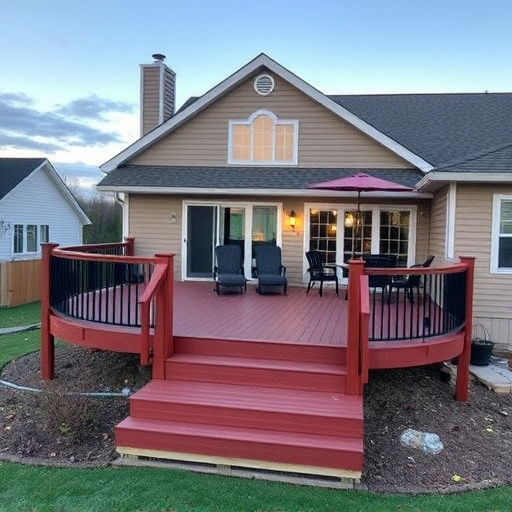Navigating Deck Builders Insurance: Slip-Resistant Decking for Risk Mitigation
Deck builders insurance is crucial for protecting businesses from liabilities related to deck constr…….
Welcome to an in-depth exploration of slip-resistant decking, a critical aspect of modern construction and design, especially in outdoor settings. This comprehensive article aims to guide readers through the intricacies of this technology, its applications, and its growing global impact. Slip-resistant decking is not merely about aesthetics; it’s a safety measure that plays a vital role in preventing accidents, particularly in wet or slippery conditions. As we delve into this topic, you’ll discover how this innovation has transformed outdoor living, from residential decks to commercial spaces, ensuring safer interactions with our surroundings.
Definition: Slip-resistant decking refers to a type of flooring or surface treatment designed to minimize the risk of slipping and falling by increasing traction. It is specifically engineered to be safer in environments where moisture, varying weather conditions, or other factors might render traditional decking surfaces hazardous.
Core Components: The primary elements that contribute to slip-resistant decking include:
Historical Context: The need for slip-resistant decking has been recognized for centuries, especially in regions with harsh weather or slippery terrain. Historically, mariners used textured wooden decks on their ships to prevent slipping while navigating rough seas. Over time, technological advancements and a better understanding of ergonomics have led to the development of sophisticated slip-resistant coatings and materials. Today, this technology is integral to many outdoor spaces, ensuring safety without compromising aesthetics.
The concept of slip-resistant decking has transcended geographical boundaries, influencing construction practices worldwide. Here’s a glimpse into its global impact:
| Region | Trends and Adoption | Key Drivers |
|---|---|---|
| North America | High adoption rate in residential and commercial sectors. Strict building codes mandate slip-resistant surfaces in public spaces and outdoor areas. | Stringent safety regulations, growing awareness of accidental falls, and a mature construction industry. |
| Europe | Increasing demand for eco-friendly options. Wooden decking with natural grip treatments gaining popularity. | Environmental consciousness, focus on long-term sustainability, and traditional wood aesthetics. |
| Asia Pacific | Rapid urbanization leading to widespread adoption in urban settings. Focus on durable and low-maintenance solutions. | Growing middle class, increasing outdoor living spaces, and a push for safer public areas. |
| Middle East & Africa | Adoption driven by luxurious outdoor living trends. High investment in commercial and resort developments. | Affluence, desire for high-end amenities, and focus on health and safety in public spaces. |
These global trends highlight the universal need for safe, durable decking solutions. As regions adapt to their unique climates and cultural preferences, slip-resistant technology continues to evolve, ensuring safer outdoor environments worldwide.
The economic landscape surrounding slip-resistant decking is dynamic and multifaceted. Here’s an analysis of its economic implications:
Market Size: The global slip-resistant flooring market was valued at USD 3.2 billion in 2021, projected to grow at a CAGR of 5.8% from 2022 to 2030 (Source: Grand View Research). This growth is attributed to the increasing demand for outdoor living spaces and safety enhancements in public areas.
Investment Patterns: The market attracts significant investment from construction materials manufacturers, technology innovators, and contractors specializing in outdoor installations. Startups focused on advanced coatings and composite materials are also gaining traction.
Economic Impact:
The field of slip-resistant decking has witnessed remarkable technological growth, pushing the boundaries of what’s possible. Here are some key advancements:
These technological leaps not only enhance the functionality of slip-resistant decking but also contribute to its longevity and ecological compatibility.
Governments worldwide play a crucial role in governing slip-resistant decking through various policies and regulations, ensuring public safety and quality construction:
While slip-resistant decking has made significant strides, it’s not without its challenges and criticisms:
Main Challenges:
Proposed Solutions:
Let’s explore a few case studies that highlight successful applications of slip-resistant decking, showcasing its transformative impact:
Case Study 1: Waterfront Park Transformation
A bustling city park with a historic waterfront needed a makeover to enhance safety and accessibility. The existing wooden decks were slippery and unstable after rainfall. By implementing a custom-designed slip-resistant deck system featuring textured concrete and non-slip railings, the park’s safety was significantly improved. This transformation allowed the park to host various community events, fostering a vibrant atmosphere while ensuring visitor safety.
Case Study 2: Luxury Resort Deck Renovations
A renowned beachfront resort sought to upgrade its aging outdoor decks while maintaining luxury aesthetics. They opted for advanced composite decking with built-in slip resistance and UV protection. The new decks not only enhanced the resort’s ambiance but also reduced maintenance costs and improved guest safety, contributing to its reputation as a premier travel destination.
Case Study 3: Urban Playground Safety
A local community group collaborated with urban planners to redesign a city playground, prioritizing child safety. They incorporated slip-resistant rubber tiles into the play area, reducing the risk of slipping during rainy days. The project was a success, encouraging more such initiatives to enhance urban outdoor spaces for all ages.
The future of slip-resistant decking is filled with promising possibilities as technology continues to evolve and global demand increases. Here are some key growth areas and emerging trends:
Slip-resistant decking is more than just a construction material; it’s a testament to human ingenuity and our commitment to safety. As we conclude this comprehensive exploration, several key takeaways emerge:
As we navigate the future, slip-resistant decking will continue to evolve, ensuring safer outdoor spaces for generations to come. This article has provided a comprehensive overview, but the journey towards enhancing safety through innovation is an ongoing one.

Deck builders insurance is crucial for protecting businesses from liabilities related to deck constr…….